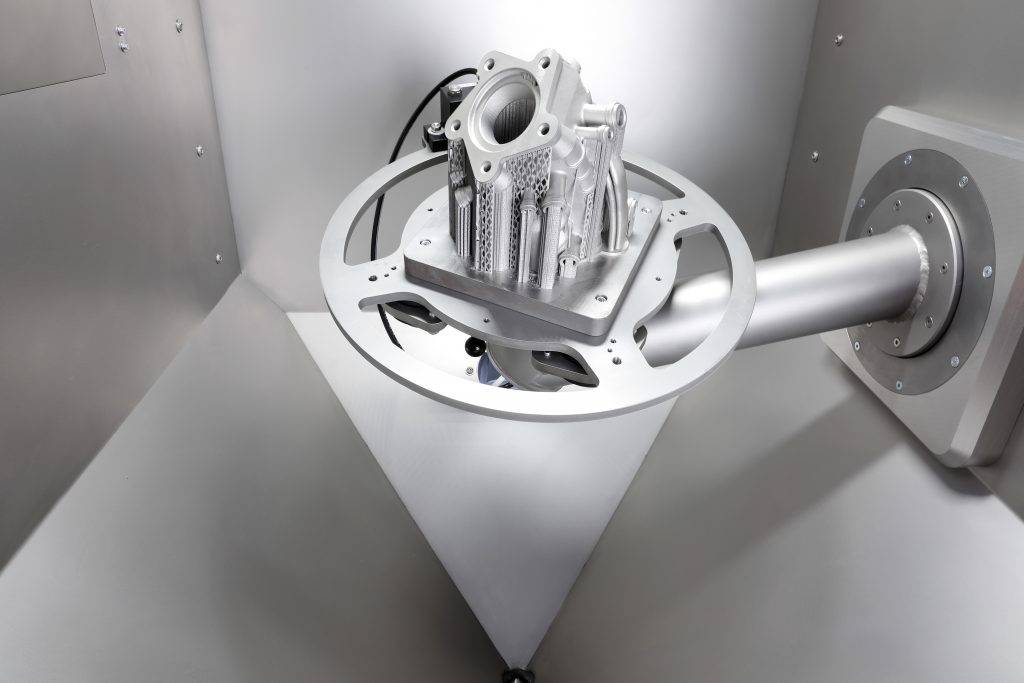Metal 3D printing generally requires a lot of work, even after the part has been printed. Not only do supports need to be removed, but excess powder needs to be cleaned off the part – and that’s easier said than done, as metal 3D printing powder is hazardous to handle, for one thing, and for another many parts are designed with channels and voids where powder can get trapped. To address these issues, German company Solukon Maschienbau GmbH has developed a series of machines that remove powder from finished 3D printed metal parts automatically. The machines rotate and vibrate the 3D printed parts, shaking loose any excess powder.
The European Organization for Nuclear Research (CERN) is well-known for its work with the Large Hadron Collider, but the organization does a lot of work with additive manufacturing as well – frequently 3D printing parts for its particle accelerators. For such a busy organization, efficiency is key, so CERN has now deployed Solukon’s automated depowdering units to clean laser melted metal parts made from reactive titanium alloys.
“Powder removal is a critical phase of Additive Manufacturing for application Ultra-High-Vacuum,” said Romain Gérard, Additive Manufacturing Engineer at CERN. “We observed that powder residues, that are subsequently sintered during heat treatment, act like sponges by trapping gases and releasing them at a very low rate. The SFM-AT300 automated depowdering unit from Solukon ensures a high depowdering quality with a safe environment for titanium and niobium powder.”
 Solukon’s depowdering machines remove powder quickly and economically, with time savings of up to 90 percent. Automatic and programmable depowdering operations make the machines easy to use, and their design is maintenance-friendly as well. The systems offer a high degree of protection from hazardous dust build-up, and inert gas infusion to prevent an explosive atmosphere. They also provide sustained inert material handling to avoid contamination with oxygen. The machines feature a sturdy design for uninterrupted operation and reproducible cleaning results for certified production processes, as well as convenient part handling. They are suitable for use with parts from all manufacturing systems on the market.
Solukon’s depowdering machines remove powder quickly and economically, with time savings of up to 90 percent. Automatic and programmable depowdering operations make the machines easy to use, and their design is maintenance-friendly as well. The systems offer a high degree of protection from hazardous dust build-up, and inert gas infusion to prevent an explosive atmosphere. They also provide sustained inert material handling to avoid contamination with oxygen. The machines feature a sturdy design for uninterrupted operation and reproducible cleaning results for certified production processes, as well as convenient part handling. They are suitable for use with parts from all manufacturing systems on the market.
“The high requirements for safety and cleaning results make CERN an exemplary customer for Solukon. The combination of the reactivity of the used titanium powder and the complex internal structures of the parts make it perfectly suitable for our systems,” said Andreas Hartmann, CEO and Technical Director at Solukon.
With the depowdering systems installed, CERN can more safely and efficiently 3D print parts for its particle accelerators, simplifying the manufacture of these parts and saving money over traditional methods of manufacturing.
“Through programmable rotation of the part and the build plate around one or two axes, non-fused build material is removed from complex voids and support structures,” said Dominik Schmid, CEO.
Solukon currently has its machines installed in the United States, Europe and Asia.
Discuss this and other 3D printing topics at 3DPrintBoard.com or share your thoughts below.
Subscribe to Our Email Newsletter
Stay up-to-date on all the latest news from the 3D printing industry and receive information and offers from third party vendors.
You May Also Like
3D Printing Financials: Fathom Struggles in Financial Quicksand During Critical Transition
Facing a year of key transitions and financial pressures, Fathom (Nasdaq: FTHM) has filed its annual report for 2023 with the U.S. Securities and Exchange Commission (SEC). The document outlines...
Latest Earnings Overview for Australian 3D Printing Firms Titomic and AML3D
Australian 3D printing manufacturing firms Titomic (ASX: TTT) and AML3D (ASX: AL3) reported their financial results for the period from July to December 2023, marking the first half of their...
3D Printing Webinar and Event Roundup: April 7, 2024
Webinars and events in the 3D printing industry are picking back up this week! Sea-Air-Space is coming to Maryland, and SAE International is sponsoring a 3D Systems webinar about 3D...
3D Printing Financials: Unpacking Farsoon and BLT’s 2023 Performance
In the Chinese 3D printing industry, two companies, Farsoon (SHA: 688433) and Bright Laser Technologies, or BLT (SHA: 688333), have recently unveiled their full-year earnings for 2023. Farsoon reported increases...
































